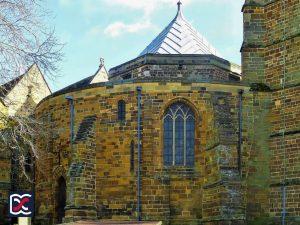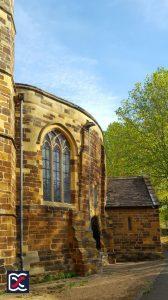Holy Sepulchre Church
Holy Sepulchre Church, Sheep Street, Northampton.
Holy Sepulchre Church is one of the oldest and most important churches in Northampton. The church is thriving today, however, parts of its history have become confused and other parts forgotten. For many years, it had been suggested that it was built by Simon de Senlis I, the third earl of Northampton, generally based on a comment that he went to Jerusalem in the “De comitissa” possibly written under the influence of Simon’s son Simon II, which tells the story of Waltheof’s widow Judith (Simon II’s great-grandmother) and their children and repeated in the ‘Delapré Chronicle’ (written by the nuns in the late fourteenth century). Exactly when Simon I died is unclear. The last grant he attested was by Henry I to Bath Abbey on 8 August 1111 at Bishop’s Waltham. It is around this time Simon died although the date of his death is not known. It may have been during the fighting on the borders of Normandy or as one chronicle suggests, as he was travelling east. He died at La Charité, ‘the eldest daughter of Cluny’, and was buried there in the great new priory church.
…the oldest round church in England!
The first specific mention of the church is in a charter that has been tentatively dated to 1116. Dr. David Carpenter as part of his recent “Charters of William II and Henry I Project” has shown that the document is most likely to have been a fake produced by the monks of the time or soon after. Dating the church by its architecture is also problematic and could be anywhere in the first half of the twelfth century. It is much more likely that it was Simon II who built the church. Charters of this time refer to him variously as “Earl Simon”, “Earl Simon of Senlis”, and “Simon, earl of Northampton”. It is noteworthy that in all of these charters he appears alongside Robert, earl of Leicester. Simon’s father-in-law. Simon II was one of the most generous patrons of the Knights Templar (founded in 1118) in England and gave the order seven hides of land at Merton (Oxfordshire) between September 1152 and August 1153. Eight tenants of the Earl were also patrons of the Templars. It is likely that the church was also the Templars preceptory in the town and Henry II donated sums of money to them “in the borough of Northampton” most years of his reign although the site is not mentioned. The two other early round churches are the Church of the Holy Sepulchre in Cambridge which was built around 1130 and Temple Church in London built in the 1180s making Northampton the oldest round church in England, even if the exact date is uncertain.

One of the rare round churches, having a circular nave (now the Baptistry), derived from the Church of the Holy Sepulchre, Jerusalem.
…it is easy to imagine the splendour and spectacle around Sheep Street and the church at the time
On 24 June 1268 another Parliament was held at Northampton. Papal Legate Ottobuono, who was about to leave for Rome, preached for a new crusade at Holy Sepulchre, and on the Feast of St. John the Baptist, Prince Edward (future King Edward I), and his brother Edmund, took the Cross. The contemporary chronicler Wykes, gives us a full description of the scene: “The Papal Legate, the Bishop of Winchester, and an innumerable multitude of English knights, and there after a solemn preaching, Prince Edward, and Prince Edmund his brother, sons of the king, Prince Henry the eldest son of the King of the Romans, the Earls of Gloucester and Warrene, Lord William de Valence and other knights to the number of one hundred and twenty, much troubled by the havoc wrought in the Holy Land, especially by the capture of Antioch by the Saracens, received on their shoulders the sign of the Holy Cross, in token of their intended expedition. Aroused by the example of the nobility, a vast number of people of either sex, and of all conditions, rushed forward to receive the cross. Of the number of knights, twenty-two were of the superior rank, termed knights-bannerets. The enthusiasm thus roused in Northampton was carried throughout the cities, boroughs, and towns of the whole kingdom, by the preaching of the Dominican and Franciscan Friars, so that a great and innumerable multitude soon bore upon their shoulders the sign of the cross. ” Just like the previous crusade which began at All Saints, it is easy to imagine the splendour and spectacle around Sheep Street and the church at the time. Edward and his wife Eleanor were still on that crusade when they heard the news that Henry III had died. They made a leisurely return to England. After their correlation, where did they go? Northampton of course!
There are references to the high altar, to the rood loft and the altars of the Blessed Virgin Mary and St. Martin. Records from the early sixteenth century also mention the chapels of St. Nicholas, St. Thomas, and John the Baptist both sharing an altar (the latter probably echoing its Templar past), and unusually St. Modwen who was an Irish noblewoman who founded Burton Abbey in Staffordshire in the 7th century. The fraternity of St. Martin is mentioned in 1476 and was associated with the town’s butchers.
Henry VIII disbanded the monasteries, priories, convents and friaries.
A massive blow to the town came with the Dissolution of the Monasteries, when from 1536 to 1541, Henry VIII disbanded the monasteries, priories, convents and friaries in England, Wales, and Ireland, appropriating their income, and disposing of their assets. The number of churches was reduced from nine to the four ancient parish churches of St. Peter’s, Holy Sepulchre, St. Giles, and All Saints.
The original church had a round nave of eight columns, supporting a triforium, and a short chancel, probably apse-ended. In circa 1180 a north aisle was added and a second was added circa 1275. During the early 15th century, a south aisle was built, the triforium of the round nave was replaced by a clerestory, and a western tower was added. The church was extended to the east during restoration work by Sir George Gilbert Scott in 1860-4. The round nave (now the Baptistry) was restored in 1868-73 and the chancel screen was made by Oldrid Scott in 1880. Major restoration works which began in the late 20th century were completed in 2009.
Mike Ingram MA, Historian, Author, and Freeman of the ancient borough of Northampton
Want to know more? Then please read Mike Ingram’s book, Northampton: 5,000 years of history.
Established in 2003, David Cosby are a firm of Chartered Surveyors and Professional Estate Agents. We have the benefit of surveying and legal expertise to help facilitate the smooth sale of your home. With successful sales throughout Northamptonshire, we have a proven track record which is supported by impressive Google reviews.
For a free market appraisal or further information on how we can assist in the sale of your home please visit our Estate Agency Home Page or call us on 01327 361664.
David Cosby Chartered Surveyors & Estate Agents




